We need your consent to use the individual data so that you can see information about your interests, among other things. Click "OK" to give your consent.
ASTM D4919-03(2008)
Standard Specification for Testing of Hazardous Materials Packagings (Withdrawn 2017)
Automatically translated name:
Standard Specification for Testing of Hazardous Materials Packagings
STANDARD published on 1.10.2008
The information about the standard:
Designation standards: ASTM D4919-03(2008)
Note: WITHDRAWN
Publication date standards: 1.10.2008
SKU: NS-29136
The number of pages: 9
Approximate weight : 27 g (0.06 lbs)
Country: American technical standard
Category: Technical standards ASTM
The category - similar standards:
Annotation of standard text ASTM D4919-03(2008) :
Keywords:
hazardous materials, packaging, packing group, Compatibility, Container leakage, Cooperage test, Drop tests--shipping containers, Hazardous materials packaging, Health hazards, Hydrostatic testing, Leak testing--packaging applications/containers, Liquids, Packing/packaging materials/systems--specifications, Performance--containers/packaging/shipping, Pressure testing--packaging/containers, Shipping containers/materials/applications--specifications, Solid phase materials, Stacking test
Additional information
| Significance and Use | ||||||||||||||||||||||||||||||||
|
The UN performance tests are based on the degree of hazard presented by the proposed hazardous material(s) to be packaged. Substances and articles which are hazardous are assigned to a specific packing group as defined in 3.8.1 and may be determined by referencing 49 CFR 172.101 hazardous materials table. Only packaging designs that have been successfully tested to the UN performance standards as defined in 3.8.2 may be marked with a UN mark. Hazardous Materials may not be transported in a packaging that does not bear the appropriate UN markings unless otherwise authorized by the applicable competent authority. Packages successfully tested to the UN performance standards may or may not withstand the North American distribution environment. To further evaluate the suitability of the package it is strongly recommended that additional tests as detailed in Practice D 4169 or other carrier specified test requirements be conducted. |
||||||||||||||||||||||||||||||||
| 1. Scope | ||||||||||||||||||||||||||||||||
|
1.1 The main focus of this guide is to identify the key information required for United Nations (UN) packaging certification to ensure the selected packaging will be certified to the appropriate level for its intended use. This document also provides guidance for locating relevant sections of the United States Department of Transportation Title 49 Code of Federal Regulations (CFR). Consult with a regulatory specialist whenever needed. 1.2 This guide is intended to assist in determining the appropriate performance tests required to certify packaging designs to the United States Department of Transportation Title 49 Code of Federal Regulations performance oriented packaging standards based on the United Nations Recommendations on the Transport of Dangerous Goods. 1.3 This guide covers the testing for transportation of hazardous materials packagings for net masses not exceeding 400 kg (880 lb) or capacities not exceeding 450 L (119 gal), excepting packagings for infectious substances, radioactive materials, cylinders and other receptacles for gases. 1.4 This guide does not replace domestic or international regulatory requirements for hazardous materials packaging but is strongly recommended to be used in conjunction with those regulations. 1.5 The user of this guide must be trained in accordance with the United States Department of Transportation Title 49 Code of Federal Regulations (49 CFR) as required by 172.700 and should be familiar with other applicable hazardous materials regulations such as; International Civil Aviation Organization (ICAO) Technical Instructions for the Safe Transport of Dangerous Goods by Air, and the International Maritime Dangerous Goods Code (IMDG Code) and carrier rules such as International Air Transport Association (IATA) Dangerous Goods Regulations. 1.6 The values stated in inch-pound units are to be regarded as standard. The values given in parentheses are mathematical conversions to SI units that are provided for information only and are not considered standard. 1.7 This standard does not purport to address all of the safety concerns, if any, associated with its use. It is the responsibility of the user of this standard to establish appropriate safety and health practices and determine the applicability of regulatory requirements prior to use. |
||||||||||||||||||||||||||||||||
| 2. Referenced Documents | ||||||||||||||||||||||||||||||||
|
Similar standards:
Historical
1.11.2012
Historical
1.4.2013
Historical
1.5.2009
Historical
1.3.2009
Historical
1.4.2008
Historical
1.11.2009
We recommend:
Technical standards updating
Do you want to make sure you use only the valid technical standards?
We can offer you a solution which will provide you a monthly overview concerning the updating of standards which you use.
Would you like to know more? Look at this page.



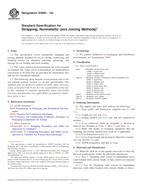 ASTM D3950-12a
ASTM D3950-12a ASTM D3953-13
ASTM D3953-13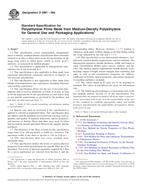 ASTM D3981-09a
ASTM D3981-09a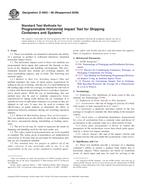 ASTM D4003-98(2009)..
ASTM D4003-98(2009)..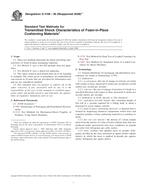 ASTM D4168-95(2008)e..
ASTM D4168-95(2008)e..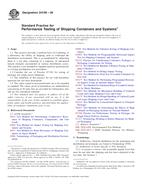 ASTM D4169-09
ASTM D4169-09
 Cookies
Cookies
